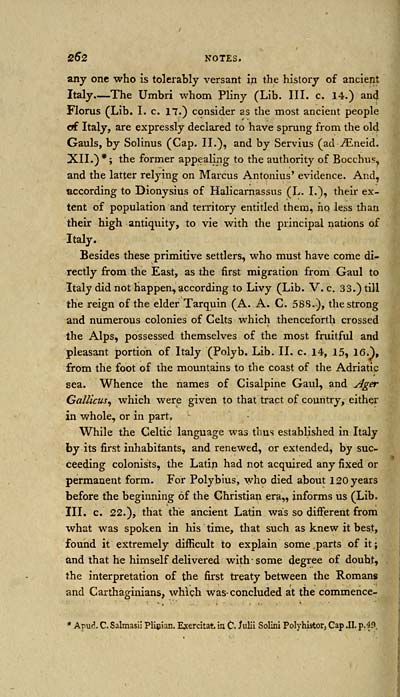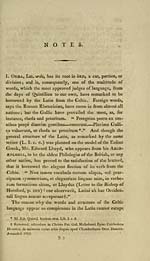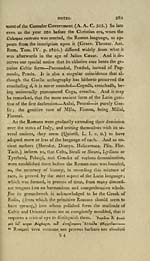J. F. Campbell Collection > Report of the Committee of the Highland Society of Scotland, appointed to inquire into the nature and authenticity of the poems of Ossian
(444)
Download files
Complete book:
Individual page:
Thumbnail gallery: Grid view | List view

262 NOTES.
any one who is tolerably versant in the history of ancient
Italy The Umbri whom Pliny (Lib. III. c. 14.) an4
Florus (Lib. 1. c. 17.) consider as the most ancient people
of Italy, are expressly declared to have sprung from the old
Gauls, by Solinus (Cap. II.), and by Servius (ad ^neid.
XII.)*; the former appealing to the authority of Bocchus,
and the latter reljnng on Marcus Antonius' evidence. And,
according to Dionysius of Halicarnassus (L. I.), their ex-
tent of population and territory entitled them, fio less than
their high antiquity, to vie with the principal nations of
Italy.
Besides these primitive settlers, who must have come di-
rectly from the East, as the first migration from Gaul to
Italy did not happen, according to Livy (Lib. V. c. 33.) till
the reign of the elder Tarquin (A. A. C. 588.), the strong
and numerous colonies of Celts which thenceforth crossed
the Alps, possessed themselves of the most fruitful and
pleasant portion of Italy (Polyb. Lib. II. c. 14, 15, 16.),
from the foot of the mountains to the coast of the Adriatic
sea. Whence the names of Cisalpine Gaul, and ^ger
Callicus^ which were given to that tract of country, either
in whole, or in part.
While the Celtic language was thus established in Italy
by its first inhabitants, and renewed, or extended, by suc-
ceeding colonists, the Latin had not acquired any fixed or
permanent form. For Polybius, who died about 120 years
before the beginning of the Christian era,, informs us (Lib.
III. c. 22.), that the ancient Latin was so different from
what was spoken in his time, that such as knew it best,
found it extremely difficult to explain some parts of it;
and that he himself delivered with some degree of doubt,
the interpretation of the first treaty between the Romans
and Carthaginians, which was- concluded at the commence-
* Apu<^. C. Salmasii Plieian. Exercitat. in C. Julii Solini Polyhistor, Cap .II, p. 49,
any one who is tolerably versant in the history of ancient
Italy The Umbri whom Pliny (Lib. III. c. 14.) an4
Florus (Lib. 1. c. 17.) consider as the most ancient people
of Italy, are expressly declared to have sprung from the old
Gauls, by Solinus (Cap. II.), and by Servius (ad ^neid.
XII.)*; the former appealing to the authority of Bocchus,
and the latter reljnng on Marcus Antonius' evidence. And,
according to Dionysius of Halicarnassus (L. I.), their ex-
tent of population and territory entitled them, fio less than
their high antiquity, to vie with the principal nations of
Italy.
Besides these primitive settlers, who must have come di-
rectly from the East, as the first migration from Gaul to
Italy did not happen, according to Livy (Lib. V. c. 33.) till
the reign of the elder Tarquin (A. A. C. 588.), the strong
and numerous colonies of Celts which thenceforth crossed
the Alps, possessed themselves of the most fruitful and
pleasant portion of Italy (Polyb. Lib. II. c. 14, 15, 16.),
from the foot of the mountains to the coast of the Adriatic
sea. Whence the names of Cisalpine Gaul, and ^ger
Callicus^ which were given to that tract of country, either
in whole, or in part.
While the Celtic language was thus established in Italy
by its first inhabitants, and renewed, or extended, by suc-
ceeding colonists, the Latin had not acquired any fixed or
permanent form. For Polybius, who died about 120 years
before the beginning of the Christian era,, informs us (Lib.
III. c. 22.), that the ancient Latin was so different from
what was spoken in his time, that such as knew it best,
found it extremely difficult to explain some parts of it;
and that he himself delivered with some degree of doubt,
the interpretation of the first treaty between the Romans
and Carthaginians, which was- concluded at the commence-
* Apu<^. C. Salmasii Plieian. Exercitat. in C. Julii Solini Polyhistor, Cap .II, p. 49,
Set display mode to: Large image | Transcription
Images and transcriptions on this page, including medium image downloads, may be used under the Creative Commons Attribution 4.0 International Licence unless otherwise stated. ![]()
| Permanent URL | https://digital.nls.uk/81747581 |
|---|
| Description | Volumes from a collection of 610 books rich in Highland folklore, Ossianic literature and other Celtic subjects. Many of the books annotated by John Francis Campbell of Islay, who assembled the collection. |
|---|
| Description | Selected items from five 'Special and Named Printed Collections'. Includes books in Gaelic and other Celtic languages, works about the Gaels, their languages, literature, culture and history. |
|---|

